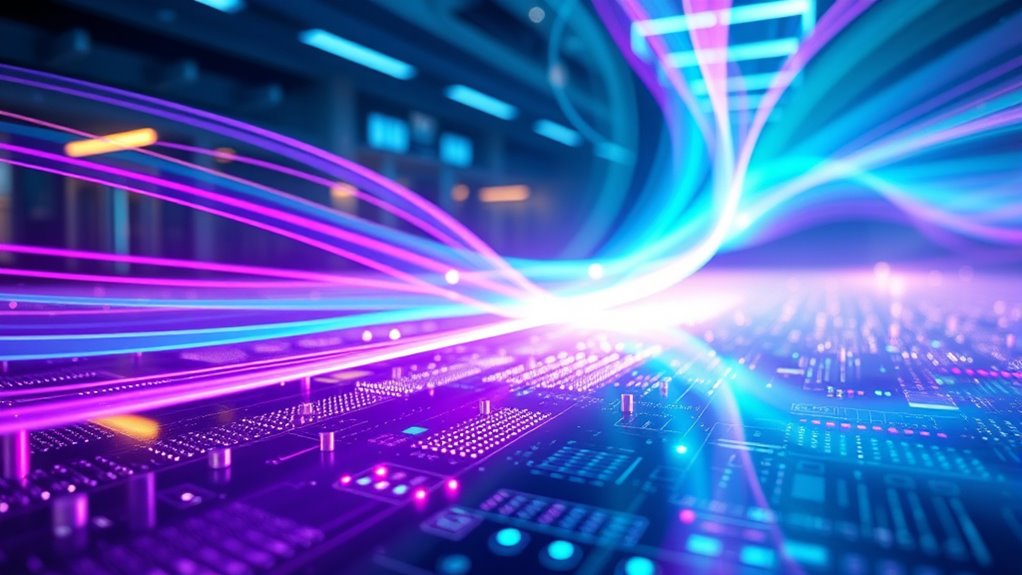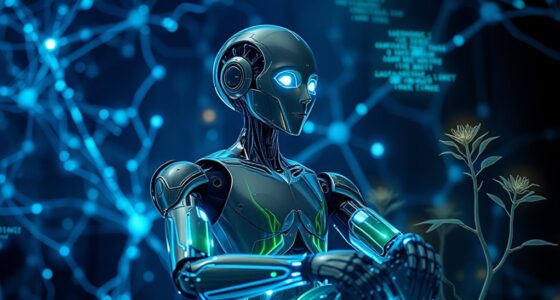Photonic computing is transforming AI by using light instead of electricity for data processing, which lets you achieve incredibly faster speeds and higher bandwidth—up to 50 times more capacity. It’s more energy-efficient, reducing power consumption and environmental impact while enabling ultra-speed data transfer critical for advanced AI tasks. This breakthrough means AI systems can grow more powerful and sustainable. If you keep exploring, you’ll discover how light is shaping the future of smarter, faster technology.
Key Takeaways
- Photonic computing utilizes light for data processing, enabling AI systems to operate at speeds and efficiencies vastly superior to electronic counterparts.
- The technology offers up to 50 times higher bandwidth and nanosecond switching, accelerating AI training and inference tasks.
- Photonic systems consume significantly less power, reducing energy costs and carbon footprints of large-scale AI data centers.
- Recent innovations like silicon photonics and optical memory enable multi-bit, low-energy, ultra-fast AI processing capabilities.
- Overall, photonic computing can boost AI power by 100×, unlocking new possibilities in real-time analytics, pattern recognition, and advanced AI applications.

Are we on the cusp of a new era in computing powered by light? Photonic computing harnesses photons—light waves—instead of electrons to process, store, and transmit data. This shift opens up revolutionary possibilities. Core components include optical processors, fiber optic data transfer systems, and optical storage devices. Because light travels faster and carries more information than electrons, photonic systems offer considerably higher bandwidth, enabling faster data flow and processing. Unlike traditional electronics, photonic computing reduces energy losses during data conversions, making all-optical systems more efficient and sustainable. This efficiency comes from eliminating the need for repeated optical-electrical-optical conversions, which typically waste about 30% of energy. Advances in photonic materials and integration techniques are further enhancing system performance. Speed is a game-changer with photonics. Photons transmit data at the speed of light, drastically cutting latency and boosting computational speeds. You could see bandwidth improvements of 10 to 50 times over conventional electronic computers, especially essential for AI workloads that demand massive, parallel processing. Optical interconnects surpass copper wiring by reducing data transmission delays, enabling seamless, rapid communication across dense computing networks. High-speed optical memory devices now reach nanosecond switching times, supporting ultra-fast data access. These advancements mean AI systems can process complex tasks more efficiently, opening doors to innovations in deep learning and real-time analytics. The integration of photonic components onto existing hardware platforms is accelerating the development of hybrid systems that combine electronic and photonic functionalities. Energy efficiency is another major advantage. Photonic systems consume less power per operation—potentially ten times less—making large-scale AI training and inference more sustainable. All-optical computing also cuts down on power used during conversion processes, further saving energy. As a result, scaling AI capabilities no longer requires proportional increases in energy consumption, helping you reduce the carbon footprint of data centers. Photonics already bolsters sustainability across global internet infrastructure through optical fibers and lasers, and its components are designed for durability, with billions of switching cycles, lowering hardware replacement needs. Recent breakthroughs include photonic memory with magneto-optic materials that enable multi-bit, high-speed, low-energy switching. Silicon photonics facilitates integrating optical components onto standard chips, creating hybrid systems that combine the best of electronics and photonics. Nonlinear optical devices are advancing the creation of optical logic operations, bringing computing closer to the versatility of electronic transistors. These innovations support a new wave of applications—from advanced AI and pattern recognition to high-speed data centers—making photonic computing a transformative force. With light now guiding the future, AI is about to get 100 times more powerful.
Frequently Asked Questions
How Soon Will Photonic Computers Be Commercially Available?
You can expect photonic computers to become commercially available around 2025 to 2026, with hardware switches and integration tools hitting the market. While widespread adoption might take until 2030, the technology is already progressing rapidly. You’ll see improvements in data transfer speeds, energy efficiency, and scalability as companies like Aeluma push innovations. Keep an eye on industry developments, because photonic computing’s impact is poised to transform high-performance systems soon.
What Are the Main Limitations of Current Photonic Technology?
The main limitations of current photonic technology are clear as day. You face issues with unreliable optical memory that wears out quickly, signal loss and noise that hinder scaling, and the difficulty of implementing nonlinear operations for complex computing. Quantum photonics also struggles with high loss rates and cooling requirements. To sum up, these hurdles make it tough to develop robust, scalable, all-photonic systems ready for widespread commercial use.
How Does Photonic Computing Compare to Quantum Computing?
You find that photonic computing focuses on classical light-based processing, excelling in speed and integration with existing tech but struggles with scalability and error correction. Quantum computing, on the other hand, leverages quantum states for powerful computation beyond classical limits, yet faces challenges like qubit coherence and hardware complexity. While photonic systems are practical for communication, quantum computing aims to revolutionize problem-solving with fundamentally different, more complex capabilities.
Will Photonic Computing Replace Silicon-Based Processors?
Photonic computing is unlikely to fully replace silicon-based processors soon. You’ll find that hybrid systems combining both technologies are more practical now, leveraging photonics for speed and energy efficiency while relying on electronics for memory and nonlinear tasks. As manufacturing and memory challenges improve, photonics will enhance current processors. But complete replacement requires overcoming significant technical hurdles, so for now, expect integration rather than outright substitution.
What Industries Will Benefit Most From This Advancement?
You’ll see the biggest benefits in AI, data centers, and telecommunications. Photonic computing boosts data transfer speeds by up to 50%, making AI training faster and more efficient. Data centers will cut energy use by half, saving costs and reducing environmental impact. Telecommunications will enjoy ultra-fast data transmission, supporting everything from streaming to 5G. These industries will rapidly adopt photonic tech, transforming how they operate and innovate.
Conclusion
As you watch the shift to photonic computing, think of it like upgrading from a bicycle to a rocket—suddenly, everything speeds up. With AI becoming 100 times more powerful, your world will feel like it’s turbocharged, revealing new possibilities at lightning speed. Just as a single spark ignites a wildfire, this breakthrough ignites a future where innovation accelerates beyond imagination, propelling you into a new era where the impossible becomes achievable in the blink of an eye.











